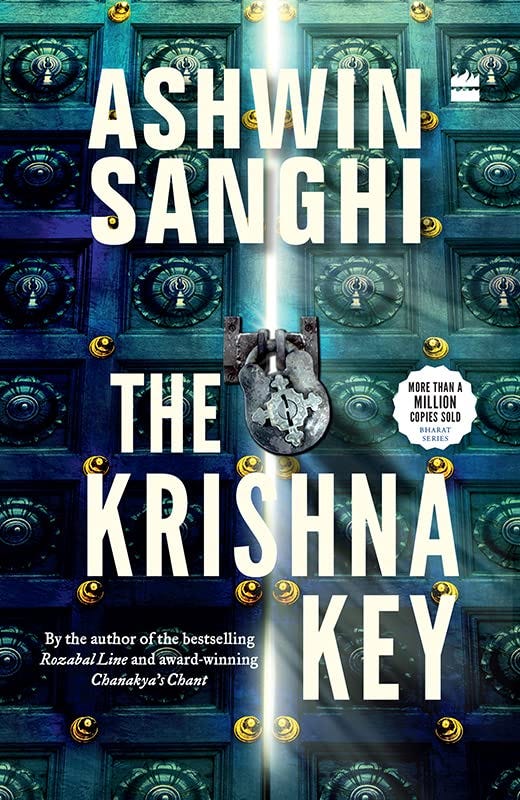The Krishna Key: A Mythological Thriller That Almost Hits the Mark
An in-depth review of Ashwin Sanghi’s The Krishna Key — a novel where ancient myths intertwine with a modern murder mystery, but does it…
An in-depth review of Ashwin Sanghi’s The Krishna Key — a novel where ancient myths intertwine with a modern murder mystery, but does it truly succeed?
A professor was murdered while writing cryptic messages, and an innocent professor was framed for the said murder. Escaping the law with the help of a female accomplice and chasing cryptic clues to religious places and other monuments, the professor tries his best to clear his name. What do you think this plot is about? It’s Da Vinci… No, it’s the Krishna Key!

The Krishna Key — a tale that lets us follow Prof. Ravi Mohan Saini, who is suddenly framed for the murder of his childhood friend. He has to solve cryptic clues left by his friend while being chased by law enforcement, serial killers and other mysterious parties. We explore multiple parts of India while solving the clues with Prof. Ravi. We explore different mysterious theories as we move from the Ruins of Dwaraka to Vrindavan and different places with a significant secret linked to Hindu mythology. Ravi has to explore and unearth these secrets to crack the clues and clear his name.
Despite its glaring similarities to Dan Brown’s Da Vinci Code, The Krishna Key does an amazing job of presenting theories linked to Indian myths and integrating them into the novel. The sections of this book can be divided into three parts. The first is the re-written myths, the small sections at the beginning of each chapter that follow Krishna. These are, in fact, my favourite parts of this book. These snippets often overshadow the plot, making it tempting to read them first.
The book’s integral part is its mythological theories. These theories are presented in appropriate places that sometimes make the reader almost accept the theories. Of course, there are a few absurdities mixed in there, too, like Mount Kailash originally being a pyramid or the theories about the Syamantaka jewel. Sometimes, these theory sessions become information dumps without significance to the story or the theory. While these mythological elements are well-executed, that’s not something we can say about the final shade of the story.
On the other side of the story, we follow the chase of Ravi. He is now chased by law enforcement and some other mysterious party that needs the answers to the clues left behind. The henchman of the other party, however, is a delusional psychopath who believes himself to be another incarnation of Lord Vishnu, just like Krishna. The problem with this aspect of the book is its characters. Except for some rare instances, the motivations of any character make no sense.
The reason why the psychopath kills or believes himself to be a god is too feeble to be believed. The father of the female accomplice, Priya Ratani, raises no objection to his daughter joining an accused murderer and wandering across the country. Despite being called “Clever” and “quick thinker”, Prof. Saini doesn’t even doubt this. The police officer, Radhika, described as strong and intelligent, suddenly becomes a frail and clueless character in some important story sequences. This makes the reader question her necessity. The antagonists are “evil” just because they have to be so. There is no compelling reason for them to do the things they do. It is as absurd as killing someone because the coffee they had was bitter.
Along with all these is an absurd love story. If this story hadn’t had much going on, this would not have been much of a problem. But when surrounded by myths, chases, conspiracies and history lessons, the love story feels extremely out of place. It just doesn’t blend well with the other parts of the story. Unfortunately, this is the book’s main story, and the other two parts exist just as the supplements. The pacing, too, suffers a bit, as it fluctuates wildly, sometimes speeding along like a race car, only to slow to a crawl like a bicycle, making the reading experience uneven.
On the one hand, things progress smoothly, while on the other end, we either have an information dump or non-sensical things happening. Hence, by the time we reach the end, we lose all the interest that brought us there in the first place. Of course, this is my perspective after reading the Da Vinci Code and other thrillers. I only enjoyed the book because it was one of the earliest fiction books I read, and I didn’t care if the story or characters were solid enough. I only questioned these points when I re-read this a few months back.
In conclusion, while The Krishna Key offers intriguing mythological theories and a solid rewritten mythology, its flawed characters, erratic pacing, and out-of-place love story make it less compelling for seasoned thriller enthusiasts. However, it’s still an entertaining weekend escape for those new to the genre. This statement is true, especially if you are new to reading fiction and haven’t read any of Dan Brown’s works. If you have read Dan Brown’s books, you have already read this book. I suggest reading any other mythological book if you are interested in Krishna’s tale.
With this, I wrap up my thoughts on The Krishna Key by Ashwin Sanghi. I can hardly place this on the B-tier list, mostly because of the interesting mythological portion of this book. Then what’s an A-tier or S-tier story, you ask? I’d suggest you stay tuned to @TheStoryTaste to find them.
Thanks for staying till the end. Until next time. Happy reading.


